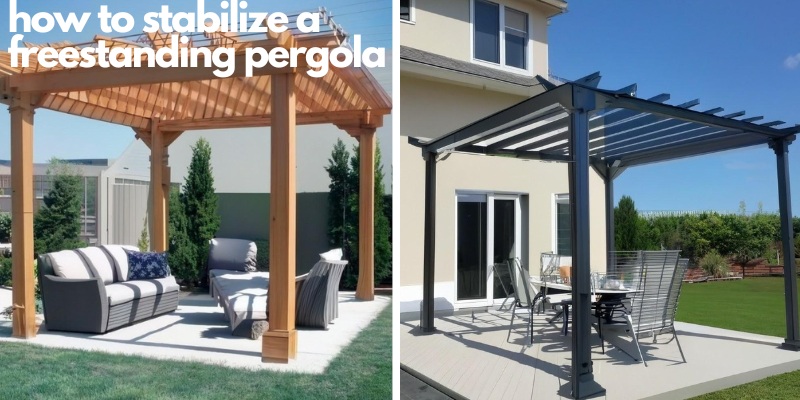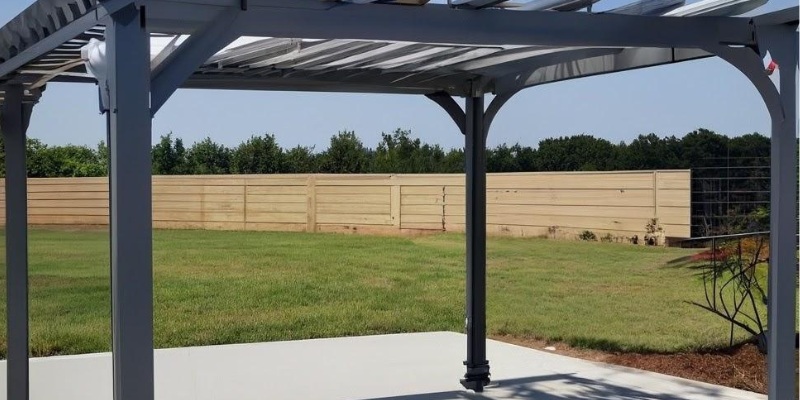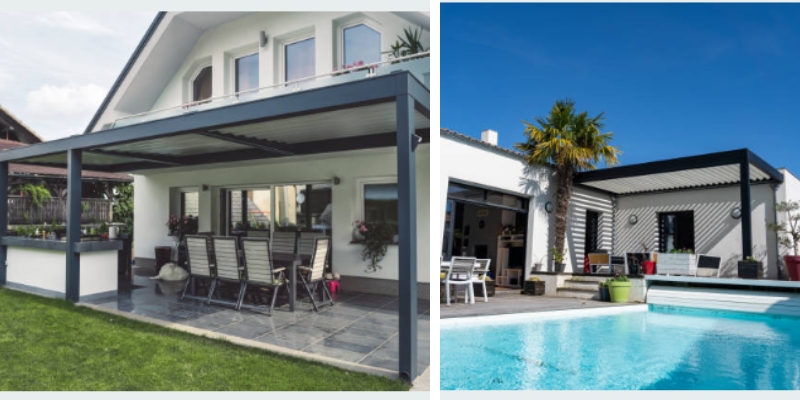How do you create a space that invites a soothing breeze and dapples your deck with the perfect balance of sunlight and shade? The answer is – a freestanding pergola.
But, there’s an essential question that often goes overlooked: how to stabilize a freestanding pergola?
Keep in mind:
From the gentlest rustle of leaves to the most robust gust of wind, your pergola must withstand it all. The secret lies not just in its construction but also in how securely anchored and stable it is. Ready to tighten the bolts and dig into the secrets of pergola stabilization?

How Do You Stabilize A Wobbly Pergola?
Let’s explore some easy ways to make your pergola stand tall and firm.
1. Pergola Posts Must Be Properly Anchored Into The Ground
A strong pergola starts from the ground up.
The posts are the legs of your pergola, and they need to be firmly planted into the soil to ensure the structure can withstand even strong winds.
How do we ensure this stability?
By digging holes deep enough to pass the frost line, then using concrete around the base of the posts. As the concrete hardens, it forms a solid, secure base, significantly adding to the stability of your pergola posts
Regular checks and maintenance of these posts and their concrete bases are key to enjoying a sturdy, weather-resistant pergola.
A little effort goes a long way in ensuring your pergola stays upright, looking elegant, and remaining steadfast, come what may.
2. Install Knee Braces or Diagonal Braces to Support the Structure
Bracing is like giving your pergola a helping hand or a support arm.
Installation of knee braces or diagonal braces helps distribute the weight of the structure, effectively reducing the load on individual posts.
These braces connect beams and posts at a 45-degree angle, adding a layer of support that counteracts the forces that may cause your pergola to sway or wobble.
So, remember, when it comes to strengthening your backyard haven, don’t skip and add bracing to keep your pergola sturdy and secure.
3. Secure the Support Beams using Lag Screws or Bolts
Now, the beams of your pergola are like the backbone of your structure, and securing them is crucial for its overall strength.
Using lag screws or bolts ensures a tight, secure connection between these beams and the supporting posts.
Regularly checking and tightening these bolts helps maintain the pergola’s resilience against wind and weight.
4. Consider Adding Extra Weight to the Pergola’s Base to Reduce Movement
Sometimes, a little extra weight goes a long way.
Adding some weight to your pergola’s base can play a pivotal role in reducing movement when you are planning to install a vinyl or a simple fiberglass pergola, especially when those strong winds come a-calling.
This could be in the form of decorative stones, a heavy outdoor furniture set, or planters filled with your favorite blooms. It’s like giving your pergola a pair of sturdy boots to keep it grounded.
But remember, balance is key.
Distribute the force of this additional weight evenly to maintain the structure’s stability and keep your pergola firmly rooted to the spot.
5. Use Guy Wires for Additional Support and Stability
Also, don’t overlook the power of guy wires.
These sturdy cables serve as unseen hands, lending extra support to your structure and enhancing stability.
They pull their weight – and that of your pergola – by adding a tension-based strength system to your structure.
By attaching them diagonally from the top of the pergola to the ground, they counteract forces that may cause your pergola to sway or tilt.
The result?
A pergola that stands tall, resolute, and unwavering.
How Do You Secure a Freestanding Pergola?

Securing a freestanding pergola involves a combination of solid planning, the right materials, and meticulous execution.
Here are six key steps for securing a freestanding pergola:
- Begin by drilling into the pavers or patio stones, an essential step that ensures your pergola has a strong foothold.
- Next up is the choice of posts. opt for durable materials like wood or aluminum. They not only support the weight of your pergola but also contribute to its overall stability.
- An often overlooked but crucial component in stabilizing a pergola is the installation of concrete post footings or rods. By anchoring your posts into these footings, you’re providing an unshakeable base for your structure.
- Consider the use of concrete anchor brackets too. They add an extra layer of stability, connecting the posts to the concrete and reducing the possibility of movement due to external forces.
- Don’t forget the role of bracing in ensuring your pergola’s stability. Diagonal braces can add significant strength to further stabilize the structure, making it more resistant to swaying.
- Lastly, but very importantly, conduct regular checks and maintenance. Even the strongest pergola can benefit from a periodic tightening of bolts and a check for any signs of wear and tear.
Can You Use Brackets To Keep A Pergola From Swaying?
Securing your pergola against the wind starts from the ground up, and brackets play a critical role in this process.
Whether your pergola is crafted from traditional wood or modern aluminum, the right brackets are essential for stability.
They provide the additional support needed to anchor and keep your pergola firmly in place, minimizing sway and enhancing overall structural integrity.
Here’s the thing:
A well-installed and well-chosen bracket ensures that the connections between your pergola’s posts and beams are tight and secure, helping the entire structure withstand strong winds.
So, when setting up your pergola, take a moment to consider the variety of brackets available. By matching your pergola’s needs with the correct bracket type, you can help create a secure, stable structure that will stand firm for years to come.
Benefits Of Keeping A Pergola From Swaying
- Extended Lifespan: A pergola that stands firm, securely anchored at ground level with its posts supported by strategic diagonal bracing, is a testament to durability. With every bolt and brace that you install, you’re effectively extending the pergola’s lifespan, ensuring it remains a long-lasting fixture in your backyard.
- Assured Safety: A solid, stable pergola is a sanctuary of safety for your family and friends. Employing secure methods like anchoring posts deep into the ground and installing a robust top beam converts your pergola into a fortress of comfort and security. It becomes more than a structure it’s a haven for loved ones to gather, chat, and create memories.
- Cost-Efficiency: A pergola that’s robustly constructed from the start demands less frequent repairs, making it a long-term economical choice. From the first drill movement to the final tightening of the lag bolts, every effort invested adds value. Over time, these initial investments translate into savings, adding to the economic appeal of your pergola.
- Uninterrupted Comfort: With your pergola securely anchored and refusing to sway in the wind, you create an environment of uninterrupted comfort.
- Boosted Home Value: A well-maintained, secure pergola serves as a highlight for potential home buyers, thus increasing the property’s market value. It’s not just an outdoor structure; it’s an investment that can add a competitive edge should you decide to sell your house.
- Peace of Mind: There’s an immeasurable benefit to knowing that your pergola is securely installed and firmly braced – peace of mind. As you sit under its shade, you can relax and savor the moment, comforted by the knowledge that your pergola is built to last, ready to withstand the test of time and weather.
Can a Freestanding Pergola Withstand High Winds?
When the wind begins to howl, can your freestanding pergola stand its ground?
Absolutely yes, Pergolas, when properly constructed and stabilized, are designed to withstand high winds.
Key to this resilience is the use of solid, securely anchored posts, robust beams, and essential bracing elements like knee braces or guy wires attached.
With the right construction methods and regular maintenance checks, your pergola can hold its own against strong winds.
What is the Best Support For a Pergola?
Deciphering the code to the best support for a pergola can often feel like finding a needle in a haystack.
However, it doesn’t have to be that complicated.
With the right blend of strength, anchoring methods, and diagonal bracing, your pergola can hold its ground against the forces of nature.
First of all, consider a scenario where you’re eyeing two posts anchored at ground level, promising a strong base for your pergola. While this is a good starting point, it’s not enough. Also, the story isn’t complete without a robust top beam, evenly distributing the weight and lending additional support.
Let’s not forget the importance of diagonal bracing, a true champion in minimizing wobbling and swaying, keeping your pergola firmly in place.
Next, consider the type of hardware you use.
Lag screws or bolts?
Each method offers its own set of advantages.
- Lag screws, for instance, provide a high level of force resistance, making them ideal for securing support beams.
- On the other hand, bolts are an excellent method of choice for attaching posts to the ground, ensuring your pergola stays upright, even under considerable pressure.
Lastly, choosing durable materials like aluminum can dramatically enhance the longevity and support your pergola.
A pergola built with aluminum reduces the chances of swaying and wobbling, ensuring a firm and secure structure.
Conclusion
Stabilizing a freestanding pergola requires careful design, good materials, and solid construction. Every aspect matters—from post hole depth to bracing strength.
Stabilized pergolas give safety, usefulness, and peace of mind. It’s about building a weatherproof structure, protecting your investment, and making your outdoor retreat last.
Maintenance is as important as installation. Pergolas last longer with regular inspections and rapid repairs. This devotion ensures the pergola can endure severe winds and extends its life, making your backyard deck an enticing place to meet, rest, and enjoy the outdoors.
Need to mention, that most of the time if you buy a pergola kit, they have all the required instructions and information on how you can stabilize it without any extra steps.
Anyway, don’t forget to consult with a specialist to evaluate your freestanding pergolas strength. Test your pergola stability. We cannot be held responsible for the stability of your freestanding pergola.


